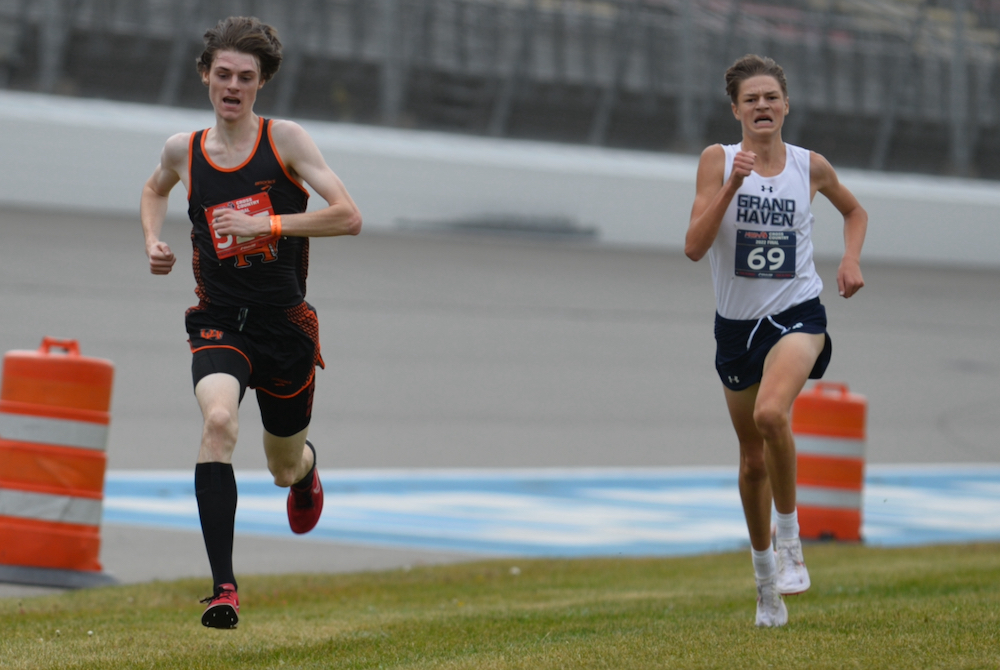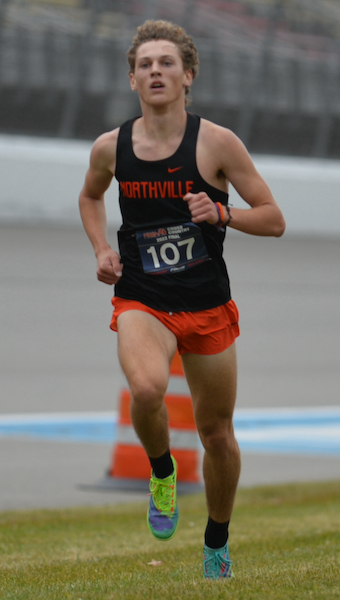
Rivals Deliver Another Classic Finish as Northville Finishes 1st as Team for 1st Time
November 5, 2022
BROOKLYN – Benne Anderson knew he had his hands full with Seth Norder, so he couldn’t allow himself to worry about the strong wind the Grand Rapids-area rivals were running into for nearly 15 minutes Saturday at Michigan International Speedway.
“You kind of just have to ignore it, kind of just push,” Anderson said. “Most of this sport is just mental. You’ve got to lock yourself in and go.”
Anderson, a senior at Grand Rapids Ottawa Hills, and Norder, a junior at Grand Haven, were locked in a sprint to the finish that appeared to be taking place in slow motion because of the heavy winds.
“It feels like you’re running with weights, like running through snow,” Anderson said.
It was Anderson who overcame the elements and the competition to win the MHSAA Lower Peninsula Division 1 championship with a time of 15:17.32. Norder was a close second in 15:18.95.
Anderson was in the lead as the runners came into view from the finish line area. Norder briefly caught him before Anderson won with one last surge.
“Any time you try to pick up the pace, the wind gets faster and faster and is slowing you down,” Norder said. “It’s really tough. I was able to catch up to him. He just had another gear. He’s a really great runner.”
 A year ago, the tables were flipped, with Norder placing second in 15:20.0 behind Hartland’s Riley Hough and Anderson taking third in 15:22.9.
A year ago, the tables were flipped, with Norder placing second in 15:20.0 behind Hartland’s Riley Hough and Anderson taking third in 15:22.9.
“I was nervous,” Anderson said. “Seth is a crazy runner. I’ve been thinking about beating him today for the whole year. I had to get my revenge from last year. He kind of stole that from me.”
Despite running in the same region of the state, it was only the second encounter this season between Anderson and Norder. They raced each other at the Portage Invitational four weeks ago, with Anderson running 14:44.1 to take second and Norder 14:45.4 to place third. The race was won by eventual four-time Division 3 champion Hunter Jones of Benzie Central.
“We’ve been racing together my whole high school career,” Norder said. “We’ve always been back and forth. I figured it would come down to a sprint-off. That’s what it did at Portage. That’s the only time we raced this year. He ended up getting me in a sprint there. I was hoping to get him here, but I came up a little short.”
Northville, which has been a regular at the MHSAA Finals, won its first team championship by scoring 122 points. Traverse City Central was second with 196 and 2021 champion Brighton was third with 229.
Junior Brendan Herger was third in 15:34.05 to lead Northville, which earned a runner-up finish in 2015. Senior Brady Heron was 14th (15:56.17), sophomore Ethan Powell was 28th (16:13.00), senior Brock Malaikal was 58th (16:31.63) and junior Nicholas Yaquinto was 85th (16:43.45) to complete the Mustangs’ scoring.
Traverse City Central placed Joe Muha (ninth) and Micah Bauer (10th) among the top 10; its next finishers were 47th, 110th and 134th overall.
PHOTOS (Top) Grand Rapids’ Benne Anderson, left, and Grand Haven’s Seth Norder sprint the stretch of the LPD1 boys championship race. (Middle) Northville’s Brendan Herger pushes toward the finish in placing third for the team champion. (Click for more from Dave McCauley/RunMichigan.com.)

MHSAA Vault: MIS Rose to Challenges to Host 2020 LP Finals
By
Rob Kaminski
MHSAA benchmarks editor
November 12, 2021
The “MHSAA Vault” features stories from past publications and other documents in the MHSAA Library. This issue takes a look at the MHSAA Cross Country Finals at Michigan International Speedway, which celebrated 25 years in 2020 – although it was an event that nearly didn’t happen last fall …
In 1996, the MHSAA and Michigan International Speedway began a partnership the changed the course of the Lower Peninsula Cross Country Finals – quite literally.
The land in and around the track at Brooklyn would host the Finals for all classes of runners in one place on one day, an annual festival of nearly 2,000 runners competing for the MHSAA’s top honors.
Even skeptics – and there were several among running purists who thought the course was too flat, for example – can’t deny the results.
Finals attendance nearly doubled in that first year, and crowds in excess of 10,000 have enjoyed a day of racing several times, including a record 12,153 in 2011.
Enthusiastic crowds were the norm in recent years, with 11,232 in 2017, and nearly 11,000 in 2018 (10,989) and 2019 (10,873).
In fact, attendance failed to reach at least 8,000 only twice since the move to MIS.
Of course, last year was an exception, when attendance was limited to 1,000 spectators per session due to the COVID-19 Pandemic. Fans also were restricted to the grandstands rather than following the action throughout locations on the course.
To reduce the number of runners in each race, the event was spread over two days, with each Division being run in two separate “sections” with times then combined at the end to determine team and individual champions.
While not ideal, the end result was another year of fantastic efforts at MIS – both from student-athletes and those behind the scenes.
“Even at the last hour, less than a week ahead of the Finals, we were closer to not having the Finals than we were to having them,” said MHSAA Assistant Director Cody Inglis, who coordinates the cross country postseason. “Rumors and challenges of mandated shutdowns, testing and other requirements were being discussed and caused a lot of unknowns. Even at the Regional level, we had schools, Regional courses and hosts shutting down their facilities; we had to relocate four Regionals 48 hours prior to race times. That scenario just could not happen at the Finals level where far more runners and much more travel would be involved.”
Among the many last-minute hurdles was the edict from NASCAR – which owns MIS – that all persons on site be temperature checked upon entry. That meant securing thermometers that were easy to operate in short order, along with personnel necessary to conduct the readings.
The attendance limitations certainly helped to implement the temperature screening, but brought their own issues.
“Limiting spectators was not a popular decision, but it really was the only way to have a race,” Inglis said. “We were taking direction and working with policies and protocols from the MDHHS, the Governor’s office, Lenawee County Health Department, MIS and NASCAR.”
Part of the solution was to utilize the grandstands as a “barrier” between participants and spectators. The reduced number of fans were dispersed over thousands of seats while still allowing them the chance to watch their student-athletes compete.
“It wasn’t the same, it wasn’t easy or perfect, but it was what we had to do to have a race,” Inglis said. “Separating the Finals into two days and different sections also allowed us to spread out the event and limit the number of people on site at any one time. This was a key part of the plan and worked well even though it separated races within a Division.”
The MHSAA, MIS and the cross country community never lost focus of the main goal: a culmination of the season for the student-athletes, who deserved something last year more than ever. And, more than ever, MIS once again displayed its advantage as a venue that could adapt to the fluid nature of the times to pull off the event.
“There were some thoughts of using four different sites, but as we learned during the Regionals, the climate of things was so tenuous from one area of the state to another that we couldn’t be 100-percent certain that there wouldn’t again be last-minute cancelations,” Inglis said. “MIS was wonderful to work and collaborate with, and was the best option to get it done. It was never mentioned once publicly about the possibility of not having the Finals – only how we could best do it under uncharted conditions.”
The moving parts and ever-changing scenarios created more complexity than ever in finalizing a season, but every decision was made with the complete desire to conduct the Finals as close to normal as possible.
“I firmly believe that a finish to the season, no matter the differences in race formatting and fan experience, was something everyone would have taken when the season began in August,” Inglis said.
Indeed, the finish line in Year 25 at MIS might have been the most gratifying of them all.

